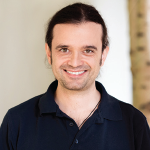Changes in the Western Ontario and McMaster University Osteoarthritis (WOMAC) Index were assessed after 12 weeks.
A Win for Ayurveda

Dr. Kessler
Dr. Kessler says, “We were quite surprised by the results. Both conventional and Ayurvedic treatment were successful. However, the Ayurveda group showed an effect of almost double that of the size of the effect of the conventional group for the primary outcome, resulting in a significant difference between the groups. This study found Ayurveda was superior to conventional guideline care for knee OA—which was already effective. It was not only statistically significant, but the effect size indicates that this is also clinically relevant.
“Among other secondary outcomes, we looked at the mental and physical subscales of the Short Form Survey 36 (SF-36) and found an interesting detail: On the mental component of the SF-36 there were no significant between-group differences, which was stunning because many people view complementary and alternative medicine as primarily (or only) exerting placebo effects. But that small detail hints that when it comes to mental quality of life, there is no significant difference between groups. However, the between-group difference for the physical subscale of the SF-36 was again significant. So we must assume that participants were not just reporting feeling great after Ayurveda therapy; … they reported very solid and sustainable physical improvements. It’s nice to see jubilant patients, but this small detail of the SF-36 supports what we saw with the WOMAC results—less pain and better movement.”
Take the Data to the Decision Makers
“This was no small pilot study,” says Dr. Kessler. “In this study, Ayurvedic treatment went head to head with conventional therapy in a country outside of India. This is an important point when discussing this with politicians or medical boards: We actually generated data on the effectiveness Ayurveda in Europe.
“It is important to take into account the setting here. … You’re not going to transform someone with a German lifestyle into someone with an Indian lifestyle,” he continued. “But you can transfer many of the timeless principles of Ayurveda to the specific needs of a German or an American. For example, dietary counseling can help people access food items useful for OA patients that are available in German supermarkets. We can’t make German knee OA patients eat curry every day, so we need to find alternatives that are still valid according to Ayurveda principles.
